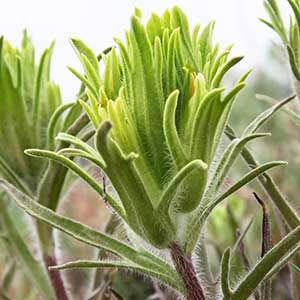Castilleja chromosa
Castilleja oresbia
desert paintbrush
pale paintbrush, pale Wallowa Indian paintbrush, pale Wallowa paintbrush
several to many, ascending to erect, often grayish, unbranched, rarely branched, sometimes with short, leafy axillary branches, hairs spreading-erect, long, stiff, eglandular, sometimes also with shorter, stipitate-glandular ones.
few to several, erect or ascending, sometimes decumbent at base, unbranched or branched, hairs usually retrorse, medium length, ± soft, eglandular, mixed with very short-glandular ones, sometimes with spreading, long, soft ones.
gray-green, linear, lanceolate, or oblanceolate, sometimes broadly lanceolate, (1.5–)2.5–6(–7) cm, not fleshy, margins plane, involute, (0–)3–5(–7)-lobed, sometimes with secondary lobes, apex acuminate to obtuse;
lobes spreading, linear, apex acuminate.
green to purple, linear to lanceolate, 2–7 cm, not fleshy, margins plane, involute, 3–5(–7)-lobed, apex acuminate to acute;
lobes spreading, linear to sometimes narrowly lanceolate, apex acute.
2.5–15 (much longer in fruit) × 1.5–5.5 cm;
bracts proximally greenish to dull purplish, distally bright red to scarlet or orange-red, rarely yellowish to dull orange or pink, narrowly to broadly linear or lanceolate, narrowly ovate, or oblong-lanceolate, (0–)3–7-lobed, rarely with secondary lobes;
lobes spreading, linear to oblong, sometimes oblanceolate, often expanded near tip, long, proximal lobes arising below mid length, apex rounded or obtuse to sometimes acute.
2.5–18 × 1–3.5 cm;
bracts pale green to yellow-green or pale, dull reddish brown throughout, or proximally so colored but changing gradually to cream or yellowish on distal margins, narrowly to broadly lanceolate, (3–)5–7(–9)-lobed;
lobes ascending, linear, long, proximal lobes arising below mid length, central lobe apex obtuse, others acute.
straight or ± curved, 18–35(–40) mm;
tube 8–15 mm;
beak short- or long-exserted, adaxially green to yellow-green, (9–)10–18 mm;
abaxial lip deep green, reduced, thickened, included to exserted, 2–3 mm, ca. 20% as long as beak;
teeth incurved, deep green, 0.5–1 mm.
straight, 21–36 mm;
tube 16–20 mm;
teeth of abaxial lip often exserted, beak exserted;
beak adaxially green, 4.2–5.5 mm;
abaxial lip green to purple, distally white, conspicuous, slightly but noticeably pouched, often visible through front cleft, 3–5 mm, 67–100% as long as beak, puberulent;
teeth erect, white, 1.8–2.1 mm.
colored as bracts, sometimes with broad yellow band below colored lobe apices, (17–)20–27 mm;
abaxial clefts 4–10 mm, adaxial 6–12 mm, abaxial ca. 30% of calyx length, adaxial ca. 40% of calyx length, deeper than laterals, lateral 1–4 mm, ca. 15% of calyx length;
lobes oblong or ovate to narrowly triangular or lanceolate, apex obtuse to rounded.
colored as bracts, 10–25 mm;
abaxial and adaxial clefts 6–7 mm, 30–60% of calyx length, deeper than laterals, lateral 5–10 mm, 40–50% of calyx length;
lobes linear, apex acute.
= 24, 48.
Castilleja chromosa
Castilleja oresbia
Castilleja chromosa is sometimes confused with 3b. C. angustifolia var. dubia (see discussion there). Castilleja chromosa retains its distinctive morphology across its wide range and is a characteristic species of much of the southwestern United States. Where it overlaps with C. angustifolia, the two are distinguished by inflorescence color and width and by the lengths of the calyx, corolla, and corolla beak. In the broad region of their sympatry, there is little evidence of intergradation, except in a few sites in Elko County, Nevada, and in southern Wyoming. Throughout southern Idaho and northeastern Nevada the range of the two overlap with little or no intergradation. At high elevations in Montrose County, Colorado, C. chromosa has narrower leaves and a longer and silkier pubescence, especially in the inflorescence. Apparent hybrids between C. chromosa and C. flava var. rustica are known from Custer County, Idaho, and hybrids with C. linariifolia are known from Montrose County, Colorado.
(Discussion copyrighted by Flora of North America; reprinted with permission.)
Castilleja oresbia is endemic to eastern Oregon and adjacent Idaho. It is easily confused with both varieties of C. pallescens, which also occur in sagebrush habitats. Castilleja oresbia has longer calyx lobes and softer pubescence than C. pallescens var. pallescens, although some transitional specimens are found. Castilleja oresbia has a combination of longer calyx lobes, longer pubescence, and obscurely nerved bracts, which usually serve to separate it from C. pallescens var. inverta. All three have different, though somewhat overlapping, ranges. Castilleja oresbia occasionally hybridizes with C. peckiana in Grant County, Oregon.
(Discussion copyrighted by Flora of North America; reprinted with permission.)


